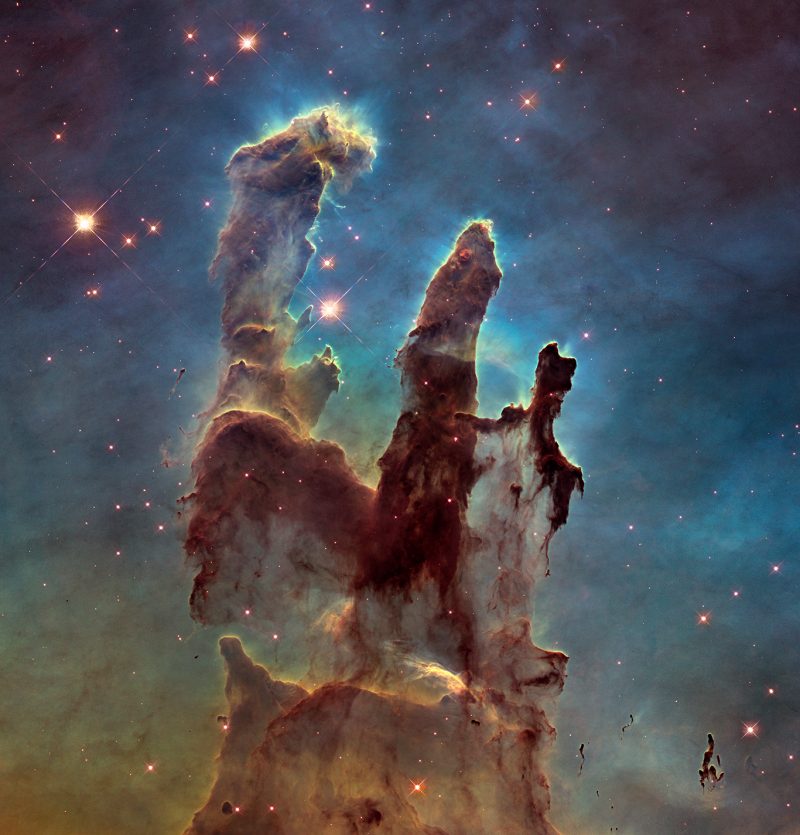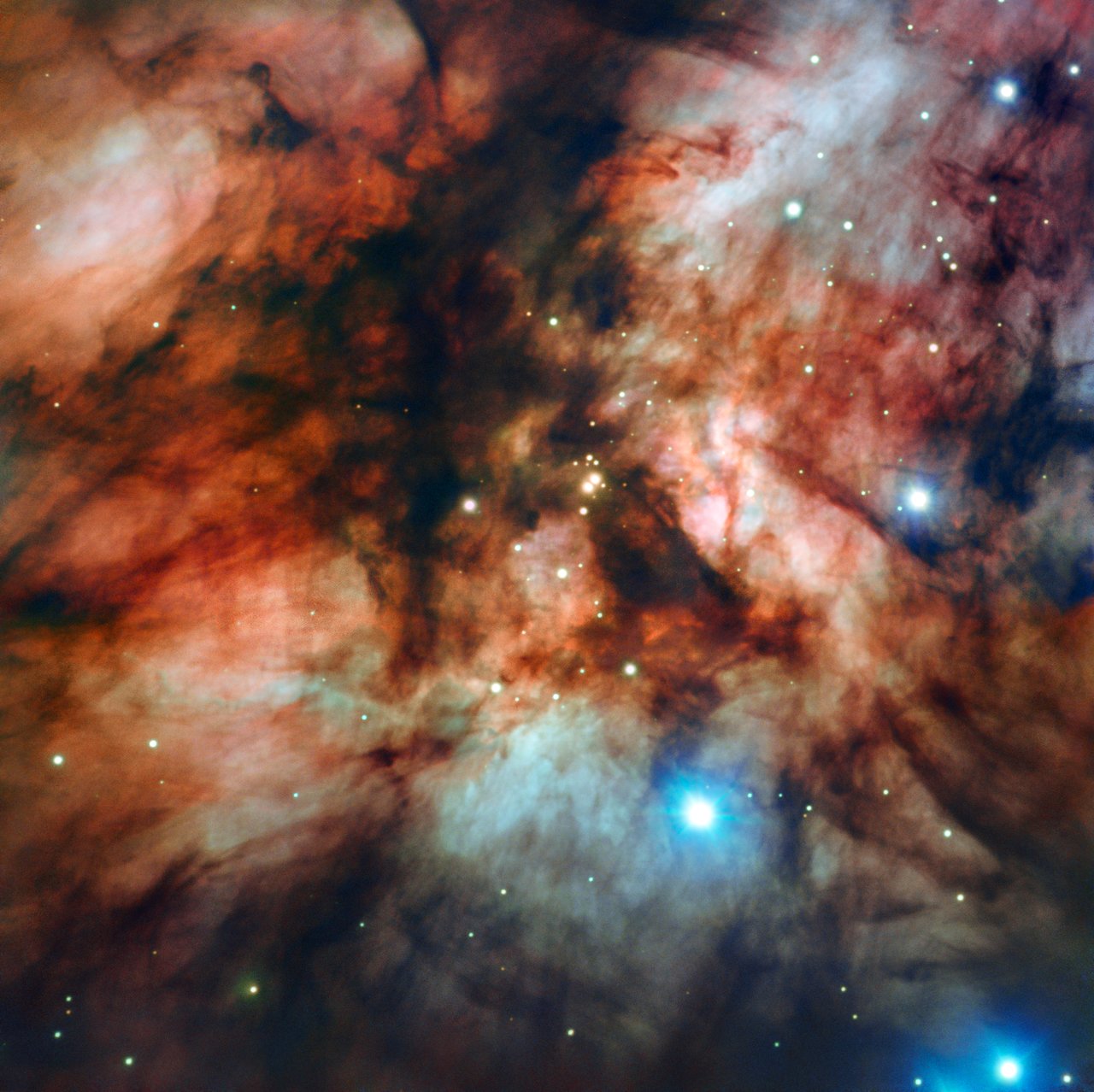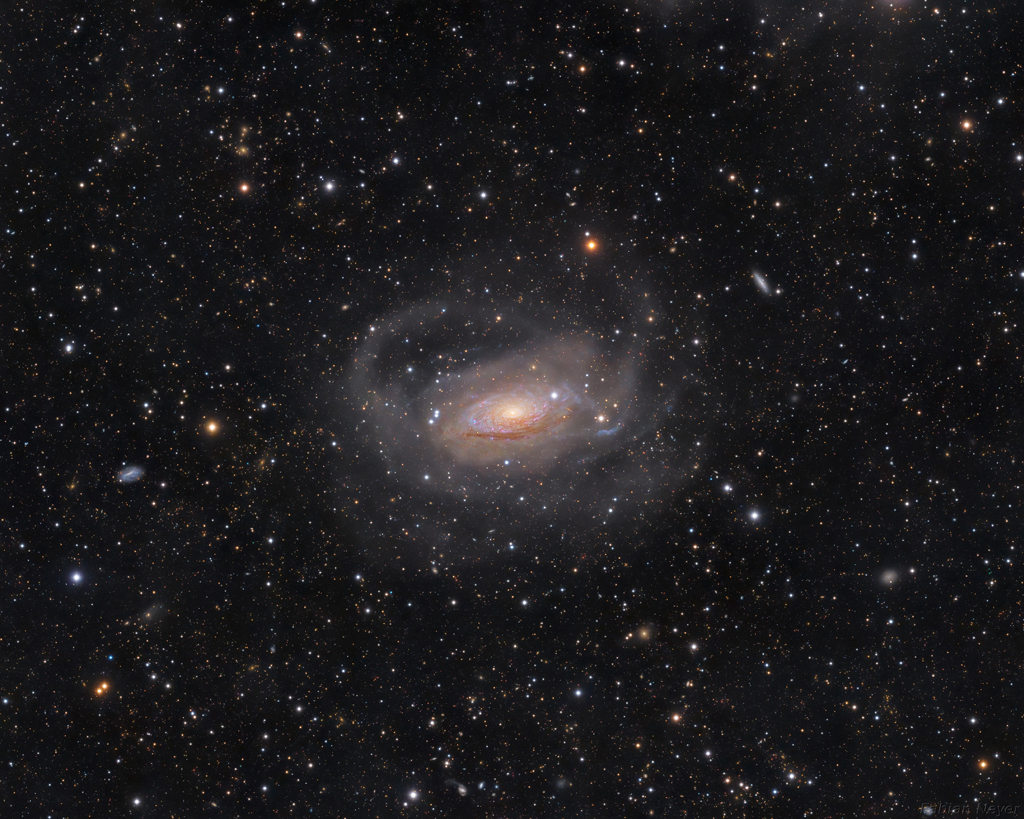The Eagle Nebula, also known as Messier 16 or M16, is one of the most amazing sights that can be seen in a large telescope. It’s the location of several famous structures including the stunning Pillars of Creation, an active star-forming region of gas and dust, depicted in the image above. The Eagle Nebula contains not only the Pillars of Creation but several other star-forming regions as well. It also has many emission nebulae, or clouds in space that shine with their own light. And it has some dark nebulae, which don’t shine themselves, but which can be seen because they obscure light from other sources.
The Eagle Nebula lies in the direction of the constellation Serpens the Serpent. It’s about 7,000 light-years away, and it’s visible in our sky at this time of year. Pic taken in 2017.

Miroslav Ladislav Vitouš (born 6 December 1947) is a Czech jazz bassist.
Born in Prague, Vitouš began the violin at age six, switching to piano after about three years, and then to bass at age fourteen. As a young man in Europe, Vitouš was a competitive swimmer. One of his early music groups was the Junior Trio with his brother Alan on drums and Jan Hammer on keyboards. He studied music at the Prague Conservatory under František Pošta, and won a music contest in Vienna that gave him a scholarship to the Berklee College of Music.
In 1967, in Chicago, Miles Davis saw Vitouš playing with Clark Terry and invited him to join his group for a residency at The Village Gate in New York City.
Vitouš recorded his debut album Infinite Search for Embryo (later issued on Atlantic as Mountain In The Clouds) in 1969 with Joe Henderson, John McLaughlin, Herbie Hancock, Jack DeJohnette, and Joe Chambers. In 1970, he also recorded Purple for Columbia with McLaughlin, Billy Cobhamand Joe Zawinul.
see full post...Zeki Müren (6 December 1931, Bursa – 24 September 1996, İstanbul) was a prominent Turkish singer, composer and actor. He was famous for his compelling voice and precise articulation in his singing of both established Turkish classical music and contemporary songs. He was awarded the title of “State Artist” in 1991 for his contributions to art. The artist, who has also given to start the first Turkish Gold Record Award, have filled music experience of more than six hundred records and tapes throughout, has composed more than three hundred songs.
see full post...
David Warren Brubeck (/ˈbruːbɛk/; December 6, 1920 – December 5, 2012) was an American jazz pianist and composer, considered one of the foremost exponents of cool jazz. Many of his compositions have become jazz standards including “In Your Own Sweet Way” and “The Duke”. Brubeck’s style ranged from refined to bombastic, reflecting both his mother’s classical training and his own improvisational skills. His music is known for employing unusual time signatures as well as superimposing contrasting rhythms, meters, and tonalities.
Brubeck experimented with time signatures throughout his career, recording “Pick Up Sticks” in 6
4, “Unsquare Dance” in 7
4, “World’s Fair” in 13
4, and “Blue Rondo à la Turk” in 9
8. He was also a composer of orchestral and sacred music and wrote soundtracks for television, such as Mr. Broadway and the animated miniseries This Is America, Charlie Brown.
Often incorrectly attributed to Brubeck, the song “Take Five“, which has become a jazz standard, was composed by Brubeck’s long-time musical partner, alto saxophonist Paul Desmond. Appearing on one of the top-selling jazz albums, Time Out, and written in 5
4 time, “Take Five” has endured as a jazz classic associated with Brubeck. Dave Brubeck was born in the San Francisco Bay Area city of Concord, California, and grew up in a city located in the Mother Lode called Ione, California. His father, Peter Howard “Pete” Brubeck, was a cattle rancher, and his mother, Elizabeth (née Ivey), who had studied piano in England under Myra Hess and intended to become a concert pianist, taught piano for extra money.
https://www.youtube.com/watch?v=CstdvrXMsK4
see full post...This cloud-strewn new image of RCW 36 (or Gum 20) was captured by ESO’s Focal Reducer and low dispersion Spectrograph (FORS). It shows one of the sites of massive-star formation closest to our Solar System, about 2300 light-years away. Located in the constellation of Vela (The Sails), the RCW 36 emission nebula is only part of an even larger star formation complex, known as the Vela Molecular Ridge. Some areas in the clouds of RCW 36 are dense enough to block out background light, creating patches and wisps of inky black. Despite the dark appearance of these clouds, they are the only places in the Universe in which star formation occurs; clumps of molecular hydrogen and cosmic dust collapse and come together to form stars encircled by small families of planets, as in our own Solar System. FORS is mounted on ESO’s Very Large Telescope, one of the world’s most advanced astronomical observatories. This image was selected as part of the ESO Cosmic Gems programme, an initiative that produces images of scientifically interesting and visually attractive objects using ESO telescopes for the purposes of education and public outreach. The programme makes use of telescope time that cannot be used for science observations. All data collected may also be suitable for scientific purposes, and are made available to astronomers through ESO’s science archive.

José Monje Cruz (5 December 1950 – 2 July 1992), better known by his stage name Camarón de la Isla (Spanish: Shrimp of the Island), was a Spanish Romani flamenco singer. Considered one of the all-time greatest flamenco singers, he was noted for his collaborations with Paco de Lucíaand Tomatito, and the three of them were of major importance to the revival of flamenco in the second half of the 20th century.
He was born in San Fernando, Cádiz, Spain, into a Romani family, the seventh of eight children. His mother was Juana Cruz Castro, a “Canastera”, literally a basket weaver, and meaning from a wandering roma family, and whose gift of singing was a strong early influence.
His father, Juan Luis Monje, was also a singer as well as a blacksmith, and had a forge where Camarón worked as a boy. His uncle José nicknamed him Camarón (Spanish for “Shrimp”) because he was blonde and fair skinned.
When his father died of asthma, while still very young, the family went through financial hardship. At the age of eight he began to sing at inns and bus stops with Rancapino to earn money. At sixteen, he won first prize at the Festival del Cante Jondo in Mairena de Alcor. Camarón then went to Madrid with Miguel de los Reyes and in 1968 became a resident artist at the Tablao Torres Bermejas where he remained for twelve years.
During his time at Tablao Torres Bermejas, he met Paco de Lucía, with whom he recorded nine albums between 1969 and 1977. The two toured extensively together during this period. As Paco de Lucía became more occupied with solo concert commitments, Camarón worked with the flamenco guitarist Tomatito.
see full post...John Weldon “J. J.” Cale (December 5, 1938 – July 26, 2013) was an American guitarist, singer, and songwriter. Though he avoided the limelight, his influence as a musical artist has been widely acknowledged by figures such as Mark Knopfler, Neil Young and Eric Clapton, who described him as “one of the most important artists in the history of rock”. He is considered to be one of the originators of the Tulsa Sound, a loose genre drawing on blues, rockabilly, country, and jazz.
In 2008, Cale and Clapton received a Grammy Award for their album The Road to Escondido.
John Cale was born on December 5, 1938, in Oklahoma City, Oklahoma. He was raised in Tulsa, Oklahoma, and graduated from Tulsa Central High School in 1956. As well as learning to play the guitar he began studying the principles of sound engineering while still living with his parents in Tulsa, where he built himself a recording studio. After graduation he was drafted into military service, studying at the Air Force Air Training Command in Rantoul, Illinois. Cale recalled, “I didn’t really want to carry a gun and do all that stuff so I joined the Air Force and what I did is I took technical training and that’s kind of where I learned a little bit about electronics.
see full post...Art Davis (December 5, 1934 – July 29, 2007) was a double-bassist, known for his work with Thelonious Monk, John Coltrane, Dizzy Gillespie, McCoy Tyner and Max Roach.
Davis was born in Harrisburg, Pennsylvania, where he began studying the piano at the age of five, switched to tuba, and finally to bass while attending high school. He studied at Juilliard and Manhattan School of Music but graduated from Hunter College.
As a New York session musician, he recorded with many jazz and pop musicians and also in symphony orchestras such as the New York Philharmonic and Los Angeles Philharmonic. He recorded with Dizzy Gillespie, Max Roach, and John Coltrane among other jazz musicians. Art Davis was a professor at Orange Coast College.
Davis is also known for starting a legal case that led to blind auditions for orchestras.
Davis earned a Ph.D. in clinical psychology from New York University in 1982. He moved in 1986 to southern California, where he balanced his teaching and practicing of psychology with jazz performances.
Davis died on July 29, 2007 following a heart attack. He was survived by two sons and a daughter.
see full post...Richard Wayne Penniman (December 5, 1932 – May 9, 2020 Macon, GA), known as Little Richard, was an American musician, singer, and songwriter. He was an influential figure in popular music and culture for seven decades. Nicknamed “The Innovator, The Originator, and The Architect of Rock and Roll“, Richard’s most celebrated work dates from the mid-1950s, when his charismatic showmanship and dynamic music, characterized by frenetic piano playing, pounding back beat and raspy shouted vocals, laid the foundation for rock and roll. Richard’s innovative emotive vocalizations and uptempo rhythmic music also played a key role in the formation of other popular music genres, including soul and funk. He influenced numerous singers and musicians across musical genres from rock to hip hop; his music helped shape rhythm and blues for generations.
“Tutti Frutti” (1955), one of Richard’s signature songs, became an instant hit, crossing over to the pop charts in both the United States and overseas in the United Kingdom. His next hit single, “Long Tall Sally” (1956), hit No. 1 on the Billboard Rhythm and Blues Best-Sellers chart, followed by a rapid succession of fifteen more in less than three years. His performances during this period resulted in integration between White Americans and African Americans in his audience. In 1962, during a five-year period in which Richard abandoned rock and roll music for born again Christianity, concert promoter Don Arden persuaded him to tour Europe. During this time, Arden had the Beatles open for Richard on some tour dates, capitalizing on his popularity. Richard advised the Beatles on how to perform his songs and taught the band’s member Paul McCartney his distinctive vocalizations.
Richard is cited as one of the first crossover black artists, reaching audiences of all races. His music and concerts broke the color line, drawing blacks and whites together despite attempts to sustain segregation. Many of his contemporaries, including Elvis Presley, Buddy Holly, Bill Haley, Jerry Lee Lewis, the Everly Brothers, Gene Vincent and Eddie Cochran, recorded covers of his works. Taken by his music and style, and personally covering four of Richard’s songs on his own two breakthrough albums in 1956, Presley told Richard in 1969 that his music was an inspiration to him and that he was “the greatest”.
Richard was honored by many institutions. He was inducted into the Rock and Roll Hall of Fame as part of its first group of inductees in 1986. He was also inducted into the Songwriters Hall of Fame. He was the recipient of a Lifetime Achievement Award from the Recording Academy and a Lifetime Achievement Award from the Rhythm and Blues Foundation. In 2015, Richard received a Rhapsody & Rhythm Award from the National Museum of African American Music for his key role in the formation of popular music genres and helping to bring an end to the racial divide on the music charts and in concert in the mid-1950s changing American culture significantly. “Tutti Frutti” was included in the National Recording Registry of the Library of Congress in 2010, which stated that his “unique vocalizing over the irresistible beat announced a new era in music”.
see full post...Alex or Aleck Miller (né Ford, possibly December 5, 1912 – May 24, 1965), known later in his career as Sonny Boy Williamson, was an American blues harmonica player, singer and songwriter. He was an early and influential blues harp stylist who recorded successfully in the 1950s and 1960s. Miller used various names, including Rice Miller and Little Boy Blue, before calling himself Sonny Boy Williamson, which was also the name of a popular Chicago blues singer and harmonica player. To distinguish the two, Miller has been referred to as Sonny Boy Williamson II.
He first recorded with Elmore James on “Dust My Broom“. Some of his popular songs include “Don’t Start Me Talkin’“, “Help Me“, “Checkin’ Up on My Baby“, and “Bring It On Home“. He toured Europe with the American Folk Blues Festival and recorded with English rock musicians, including the Yardbirds, the Animals, and Jimmy Page. “Help Me” became a blues standard, and many blues and rock artists have recorded his songs.
Miller’s date of birth is disputed. In a spoken word performance called “The Story of Sonny Boy Williamson” that was later included in several compilations, Miller states that he was born in Glendora, Mississippi in 1897. A counter claim is made that he was born Alex Ford (pronounced “Aleck”) on the Sara Jones Plantation in Tallahatchie County, Mississippi. Another claim is that he was born on December 5, 1899. David Evans, professor of music and an ethnomusicologist at the University of Memphis, claims to have found census records that Miller was born around 1912, being seven years old on February 2, 1920, the day of the census. However, it has been argued that a census record claim of age without a birth certificate is not a reliable proof, as census clerks often made mistakes, especially in rural towns where few people could read or write. Miller’s gravestone in or near Tutwiler, Mississippi, set up by record company owner Lillian McMurry twelve years after his death, gives his date of birth as March 11, 1908.
see full post...A bright spiral galaxy of the northern sky, Messier 63 is nearby, about 30 million light-years distant toward the loyal constellation Canes Venatici. Also cataloged as NGC 5055, the majestic island universe is nearly 100,000 light-years across, about the size of our own Milky Way. Its bright core and majestic spiral arms lend the galaxy its popular name, The Sunflower Galaxy, while this exceptionally deep exposure also follows faint, arcing star streams far into the galaxy’s halo. Extending nearly 180,000 light-years from the galactic center the star streams are likely remnants of tidally disrupted satellites of M63. Other satellite galaxies of M63 can be spotted in this remarkable wide-field image, made with a small telescope, including five newly identified faint dwarf galaxies, which could contribute to M63’s star streams in the next few billion years.

Cassandra Wilson (born December 4, 1955) is an American jazz singer, songwriter, and producer from Jackson, Mississippi. She has been described by critic Gary Giddins as “a singer blessed with an unmistakable timbre and attack [who has] expanded the playing field” by incorporating blues, country, and folk music into her work.
Cassandra Wilson is the third and youngest child of Herman Fowlkes, Jr., a guitarist, bassist, and music teacher; and Mary McDaniel, an elementary school teacher who earned her PhD in education. Her ancestry includes Fon, Yoruba, Irish and Welsh. Between her mother’s love for Motown and her father’s dedication to jazz, Wilson’s parents sparked her early interest in music.
Wilson’s earliest formal musical education consisted of classical lessons; she studied piano from the age of six to thirteen and played clarinet in the middle school concert and marching bands. When she was tired of this training, she asked her father to teach her the guitar. Instead, he gave her a lesson in self-reliance, suggesting she study Mel Bay method books. Wilson explored guitar on her own, developing what she has described as an “intuitive” approach. During this time she began writing her own songs, adopting a folk style. She also appeared in the musical theater productions, including The Wizard of Oz as Dorothy, crossing racial lines in a recently desegregated school system.
Wilson attended Millsaps College and Jackson State University. She graduated with a degree in mass communications. Outside of the classroom, she spent her nights working with R&B, funk, and pop cover bands, also singing in local coffeehouses. The Black Arts Music Society, founded by John Reese and Alvin Fielder, provided her with her first opportunities to perform bebop. In 2007, Wilson received her PhD in Arts from Millsaps College.
In 1981, she moved to New Orleans for a position as assistant public affairs director for the local television station, WDSU. She did not stay long. Working with mentors who included elder statesmen Earl Turbinton, Alvin Batiste, and Ellis Marsalis, Wilson found encouragement to seriously pursue jazz performance and moved to New York City the following year.
see full post...Terence Woods (born 4 December 1947 in Dublin, Ireland) is an Irish folk musician, noted for playing the mandolin and cittern, but also plays acoustic and electric guitar, mandola, five-string banjo and concertina. He is also a singer and songwriter. He is known for his membership in such folk and folk-rock groups as The Pogues, Steeleye Span, Sweeney’s Men, The Bucks and, briefly, Dr. Strangely Strange and Dublin rock band Orphanage, with Phil Lynott, as well as in a duo/band with his then wife, Gay, billed initially as The Woods Band and later as Gay and Terry Woods. Woods has toured with The Pogues on their reunion concerts.
see full post...